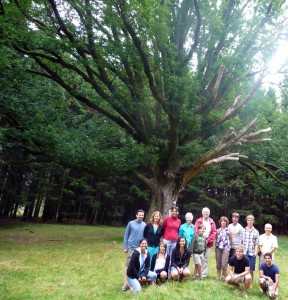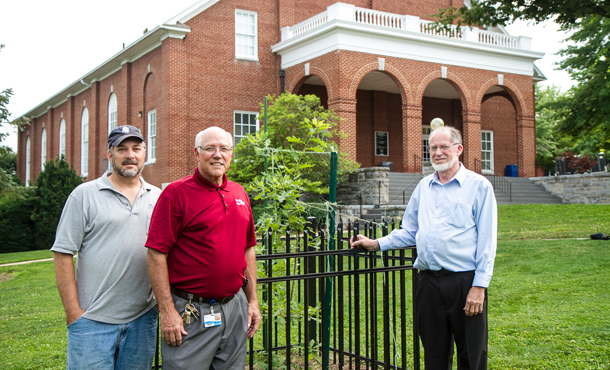In the closing years of the 18th century, the Mennonites in Salm – an isolated community in the Vosges Mountains in modern-day Alsace, France – were facing a familiar predicament. Yet another European war was being fought, and yet another army was in need of soldiers to fill its ranks. This particular time, an officer arrived in Salm with orders for all the men in the village to do military service with the government installed during the French Revolution, according to local oral history.
The Mennonite bishop in the community, Jacob Kupferschmidt, invited the officer into his home, where he sang a hymn from the Ausbund, the old Anabaptist hymnal, and gave a moving speech on his church’s peace convictions. After eating lunch together, the officer cut Bishop Kupferschmidt an informal deal: if the men of Salm stayed home to work their farms, they wouldn’t have to join the army.
Not long thereafter, a group of Mennonites went to Paris to seek official exemption from military service from the government. Their wish was granted,* and upon their return to Salm, Bishop Kupferschmidt planted an oak tree on his property to commemorate the good news. He named it the Peace Oak.

More than 200 years later, James Hershberger, an avid amateur historian from Augusta County, Virginia, first heard this story and saw the aging Peace Oak during a visit to Salm while touring Anabaptist historical sites in Europe.
The tree, now so large that it takes four people stretching fingertip to fingertip to encircle its trunk, reminded him of another oak not far from his home in the Shenandoah Valley, beneath which General Stonewall Jackson was said to have led his men in prayer before a Civil War battle. Until that oak fell down several years ago, people would collect its acorns to plant “Jackson prayer trees” of their own. Standing beneath Bishop Kupferschmidt’s Peace Oak in France, Hershberger was similarly inspired to grow new trees – albeit ones symbolizing peace, not war – from the historic oak.
“I thought that it was just such a wonderful story, and that we should have some American Peace Oaks,” says Hershberger, who belongs to a Beachy Amish congregation in Augusta County.
In the years since, Hershberger has received several batches of acorns gathered during the autumn from beneath the French Peace Oak, and has begun, through a process of trial and error, to establish a second generation of these trees in North America. The first half-dozen seedlings he started all died. Two of the next batch of another half-dozen or so actually hung on and appear to be thriving in his back yard. Another one from the third batch now stands in his front yard. (Along the way, he has been refining his silvicultural techniques with help from public forestry officials.)
In 2010, he offered a third-batch seedling to Eastern Mennonite University (EMU), which he figured would be interested in growing a tree on campus that symbolizes the long Mennonite commitment to nonviolence. He was right, and after some internal back-and-forth, a site on the lawn north of Lehman Auditorium was chosen – a prominent spot uncomplicated by any near- or long-term construction plans, according to physical plant director Eldon Kurtz.
Hershberger planted the oak there, but it never really did that well, and eventually, was broken off entirely – perhaps trampled by children at play. In 2011, Hershberger brought another seedling (he has a standing order with friends for any acorns they can collect in Salm), amended and reworked the soil a bit, and planted Peace Oak number two.
For some time, the oak just sat there, neither dying nor getting any bigger. After the destruction of the first Peace Oak, Kurtz decided to give the second one better protection; a tall black fence, almost cemetery-like, now surrounds the Peace Oak. Dale Shank, president and owner of the Harrisonburg fence company Dutch Way, donated the fence that surrounds the Peace Oak
“It’s a special tree,” says Kurtz. “We’re trying to protect it.”
This year, conditions seem to have finally favored the Peace Oak, which has gone through a growth spurt and now stands about seven feet tall. Hershberger, who took a class (ornithology) at EMU decades ago but graduated with a degree in education from James Madison University in 1972, stops by as often as he can to look in on it, sometimes as often as every other week.
He continues to plant acorns from the original Peace Oak in Salm, and has become a sort of Johnny Appleseed of Peace Oaks. Two other Anabaptist institutions – the Valley Brethren-Mennonite Heritage Center in Harrisonburg, Virginia, and the Amish and Mennonite Heritage Center in Berlin, Ohio – also now have Peace Oaks thanks to Hershberger.
“I think of this as a gift that we’ve received from previous generations, and these ideals represented by the tree are something we can emulate,” says Hershberger. “I would like to see these trees grow peace.”
______________________
* On August 18, 1793, the French government responded to the Anabaptists’ appeal as follows:
The Anabaptists of France have sent several of their number to us to explain that their fear of God and church discipline forbids them to bear arms and requested that they be assigned to other duties in the army. We have observed in them, honest hears, and therefore, believing that a good government should promote all virtues that are upbuilding to the community, we advise you to treat the Anabaptists with the same gentleness and non-violence which they themselves display, to prevent them from being persecuted, and to permit them to serve their army terms as they may desire, in such duties as building fortifications, working on the roads, transporting supplies, or if they wish by payment of an exemption fee.
[Source of this 1793 statement: Unpublished manuscript by Verne Schirch, who credits Amish author Leroy Beachy and his book Unser Liet. Schirch’s manuscript, a family history book, also cites a few locals of Salm, France, who believe that the oak tree is older than 1793-94. The accuracy of the tree’s age can only be determined after it dies and its trunk circles are counted.]
